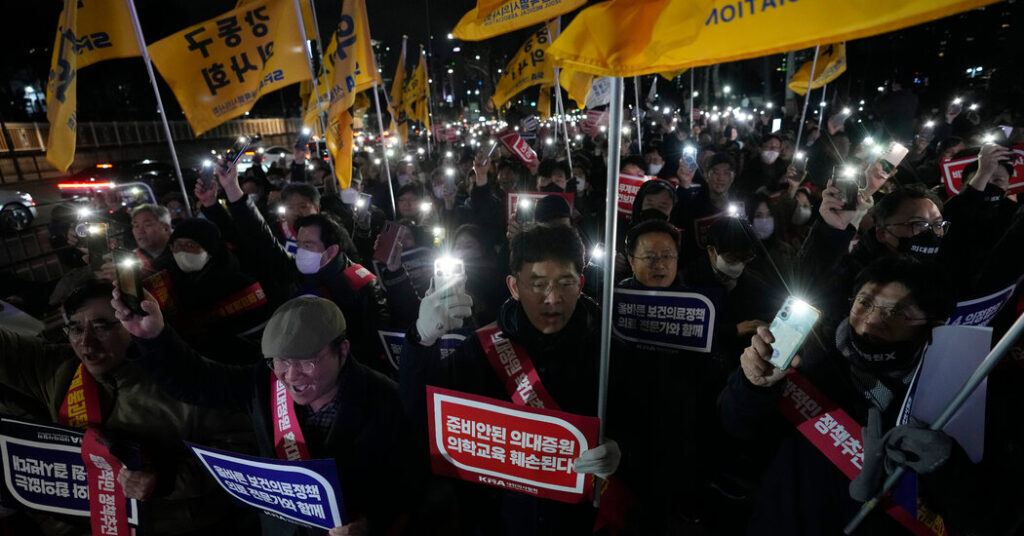Hundreds of interns and residents at main South Korean hospitals walked off the job on Tuesday, disrupting an important service to protest the federal government’s plan to deal with a scarcity of medical doctors by admitting extra college students to medical faculty.
While South Korea takes delight in its inexpensive well being care system, it has among the many fewest physicians per capita within the developed world. Its quickly ageing inhabitants underscores the acute want for extra medical doctors, in accordance with the federal government, particularly in rural elements of the nation and in areas like emergency medication.
The protesters, who’re medical doctors in coaching and essential for preserving hospitals operating, say the scarcity of medical doctors will not be industrywide however confined to specific specialties, like emergency care. They say the federal government is ignoring the problems which have made working in these areas unappealing: harsh working situations and low wages for interns and residents.
Surveys have discovered that in a given week, medical doctors in coaching often work a number of shifts that last more than 24 hours, and that many are on the job for greater than 80 hours every week.
“The medical system has been collapsing for a while,” mentioned Park Dan, the pinnacle of the Korean Intern Residents Association, who resigned from his job on the emergency wing of Severance Hospital in Seoul on Monday. “I couldn’t see a future for myself working in emergency for the next five or 10 years.”
The present setup of insurance coverage and authorities cost techniques, Mr. Park added, permits physicians solely in a number of departments, like beauty surgical procedure, to make a good residing.
The protesting medical doctors additionally say that by rising the variety of physicians, the federal government dangers creating extra competitors that might result in the overtreatment of sufferers.
Early this month, President Yoon Suk Yeol’s administration introduced a plan to lift the nation’s medical faculty admissions quota by 65 p.c. Licenses to observe medication are regulated by the Ministry of Health and Welfare. The plan was instantly criticized by medical doctors, who took to the streets with indicators that learn “end of health care.”
Trainee medical doctors at 5 of the most important hospitals in Seoul, the place many of the nation’s folks dwell, submitted resignations on Monday and left their posts at 6 a.m. on Tuesday. More than 6,000 medical doctors in coaching, over half of the nation’s younger physicians, have resigned, however their employers haven’t accepted the resignations, a well being ministry official mentioned on Tuesday.
Medical facilities had been already reporting disruptions in operations on Monday afternoon, together with Severance Hospital, one of many nation’s largest, which mentioned it had reduce on companies and canceled half of all deliberate surgical procedures.
Officials have urged the medical doctors to remain of their posts, warning of authorized repercussions for many who fail to conform. On Monday, the Health Ministry mentioned it could droop the licenses of two members of the Korean Medical Association who had been among the many most vocal critics of the federal government’s plan. The affiliation, the nation’s largest group of medical doctors, declined to remark.
Laws allow the federal government to drive some medical doctors again to work in the event that they concern disruption of care. Officials have mentioned that they may depend on telemedicine operators and even navy medical doctors till the matter is resolved.
There is broad public help in South Korea for rising the medical faculty quota, which has basically been unchanged since 2006. The nation has about 2.6 medical doctors per 1,000 folks, in contrast with a median of three.7 within the international locations belonging to the Organization for Economic Cooperation and Development.
Mr. Yoon’s plan would increase medical faculty admissions to about 5,000 per 12 months from 3,000. If the admissions quota will not be elevated, officers predict, by 2035 the nation can have about 10,000 fewer medical doctors than it wants.
This will not be the primary time lately that the federal government has pushed for extra medical doctors. In 2020, President Moon Jae-in’s administration proposed rising medical faculty admissions by 4,000 over 10 years. The plan was placed on maintain after a backlash from the medical neighborhood, centered on considerations just like the present ones, and a monthlong strike by physicians.


